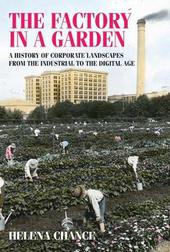
|
The Factory in a Garden: A History of Corporate Landscapes from the Industrial to the Digital Age
Hardback
Main Details
Description
This book aims to explore the designed landscapes associated with factories and corporations in the UK and US created since the industrial revolution. It is largely historical, focusing on the period between 1890 and 1930 but it comes right up to date with initiatives such as secret gardens and vegetable allotments at the London Google offices. -- .
Author Biography
Helena Chance is Reader in History and Theory of Design at Buckinghamshire New University -- .
Reviews'These gardens have not been much studied, so that Helena Chance's The Factory in a Garden: a History of Corporate Landscapes from the Industrial to the Digital Age comes as a welcome addition to the garden library. Chance covers the period from Robert Owen in the early 19th century to the carefully designed office gardens of today but she majors on two sites: Bournville, the landscape and village surrounding the Cadbury chocolate factory near Birmingham in the UK, and the National Cash Register Company's complex in Dayton, Ohio. This is a formidable work of scholarship.' Richard Mawrey, Historic Gardens Review, No 44 'For those who studygarden and labor history, The Factory in a Garden is an interestingbook. By documenting the history of these spaces and theorizing about theirbenefits and the intentions of their creators, Chance has written a wonderfulwork that will be referenced by garden history and labor history scholars foryears to come.' Esther Jackson, NYBGPlant talk 'The Factory in a Garden draws from multidisciplinary sources, is comprehensively referenced and well illustrated by many archival images. The author also devotes a chapter to the use of garden images in lantern slides, photographs and promotional films, providing a unique visual glimpse of the development of the corporate image. Comparisons between corporate landscapes in Britain and the United States are the focus of this book, and although Bournville may be well known to many, some of the American companies selected for study, such as Shredded Wheat and Heinz, are household names in the UK and will undoubtedly be of interest to a British readership. [...] In recent years there has been an increasingly important debate on the health and well-being of society. Much of this has focused on designing and managing green spaces, landscape and the wider environment for the benefit of the family and community. Helena Chance's publication will contribute to this expanding body of literature by its focus on the benefits of green space in the workplace.' Barbara Simms, Garden History, Vol. 46, No. 1 (Summer 2018) 'The factory in a garden presents a history of corporate gardens and designed landscapes in the United Kingdom and USA from the early Industrial Revolution to the heyday of the factory garden in the years running up to World War II [...]The central theme is the relationship between two productive spaces: landscape designed for pleasure and leisure and industrial sites for work and economic output. The book traces the history of such landscapes from the 18th century rurally-located mills of the UK, through planned industrial communities such as Saltaire, to the leafy campuses of tech businesses in Silicon Valley.' Robin Thornes, Transactions of the Ancient Monuments Society, Volume 63 (2019) -- .
|